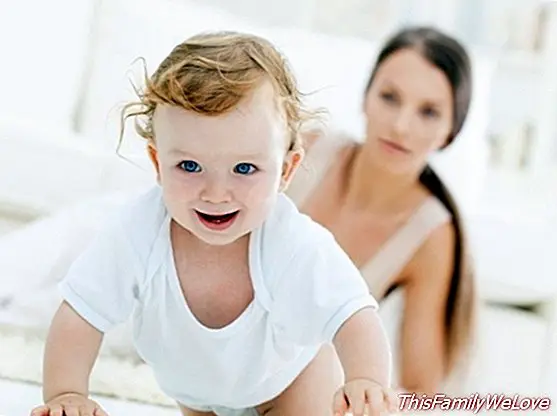The importance of crawling for the baby

The moment your baby starts to crawl, you can discover the world when and how you want it. This new feat is more important than we imagine for its future physical and intellectual development. In general, most children begin to crawl around eight or ten months. At that age, the child already has enough strength in his muscles to crawl on the ground.
From the simple movement of "drag" you move to the position of "four legs" and from there, around the year, to more upright positions.
Many people are unaware of the crucial importance of crawling in children: it is something basic for the development of vision, tactility, speech, balance, craft, orientation and own perception as well as other important functions. As a result of this lack of knowledge, it often happens that many children do not crawl. They spend the day in the little park and practically begin to walk without having come to crawl. And this error can cause multiple dysfunctions when they grow up.
8 benefits of baby crawling
Crawling is a stage of the development of the baby that brings many benefits for the future:
1. The crawling connects the cerebral hemispheres and favors brain development. This facilitates the passage of information from one hemisphere to another and forms the basis of the higher functions of movement. In addition, this development is essential for the maturation of different cognitive functions.
2. Develop the cross pattern. This pattern is the neurological function that makes possible the organized and balanced corporal displacement. It implies that the right arm is synchronized with the left foot and the left arm with the right foot. Thanks to this way of moving (which does not damage the vertebrae), the muscles that will later allow the child to keep the spine perfectly erect to stand up are adequately toned.
3. Develops the vestibular system and the proprioceptive system. Both systems allow to know where the body parts are.
4. Develops visual convergence and enables the focus of the eyes. Crawling is a good muscular exercise for the eyes that facilitates the visual accommodation, that is, that the eyes of the baby are positioned correctly. And such is its importance that, according to studies of optometrists, 98% of children with strabismus did not crawl enough when they were small.
5. Develop cortical opposition, which is that the thumb can oppose the other four fingers. The child feels the touch of the hands with which it moves and this provides the development of this function, which is what allows you to use them and pick up objects.
6. The child learns to measure the world around him and adapts to the environment. The distance between the eyes and the palm of the hand when crawling is a fundamental physical measurement with which the child measures the surrounding world and adapts better to the environment because it constantly measures it and resumes spatial information in an orderly manner.
7. Help to establish the future lateralization. During the crawling the connection between the two cerebral hemispheres takes place, so that more complex functions can begin to develop; thus, when the child is growing, lateralization occurs: one hemisphere "sends" over the other. A small child who is going to catch a ball throws both hands at once because the order comes simultaneously to both hemispheres. A child with a higher level of organization takes the ball that is sent rolling with one hand or another depending on which is the dominant hand (right or left handed).
8. Help to be able to write in the future. With the crawling the coordination between the eye and the hand is developed. In this way, functions such as reading and writing will be favored in the future, since the child will also keep the necessary distance.
Teresa Pereda
You may also like:
- Baby crawling
- The first steps of the baby
- Learning to walk, is my baby ready?
- Baby shoes, five fun models to learn to walk




